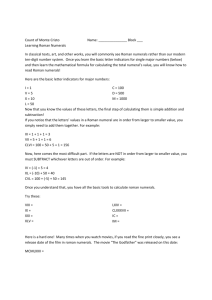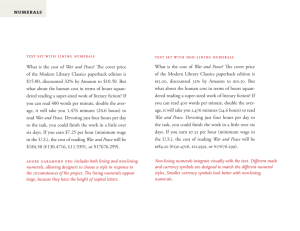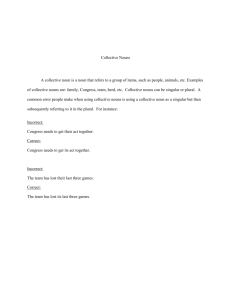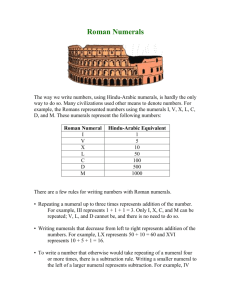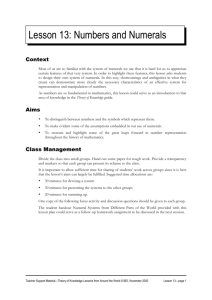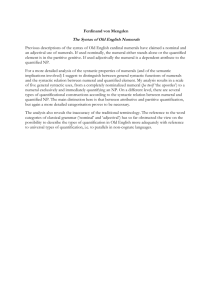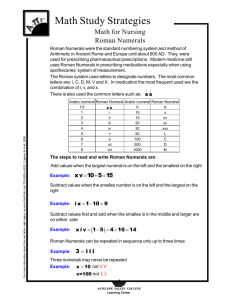Russian Numerals with Nouns Denoting Human Beings
advertisement
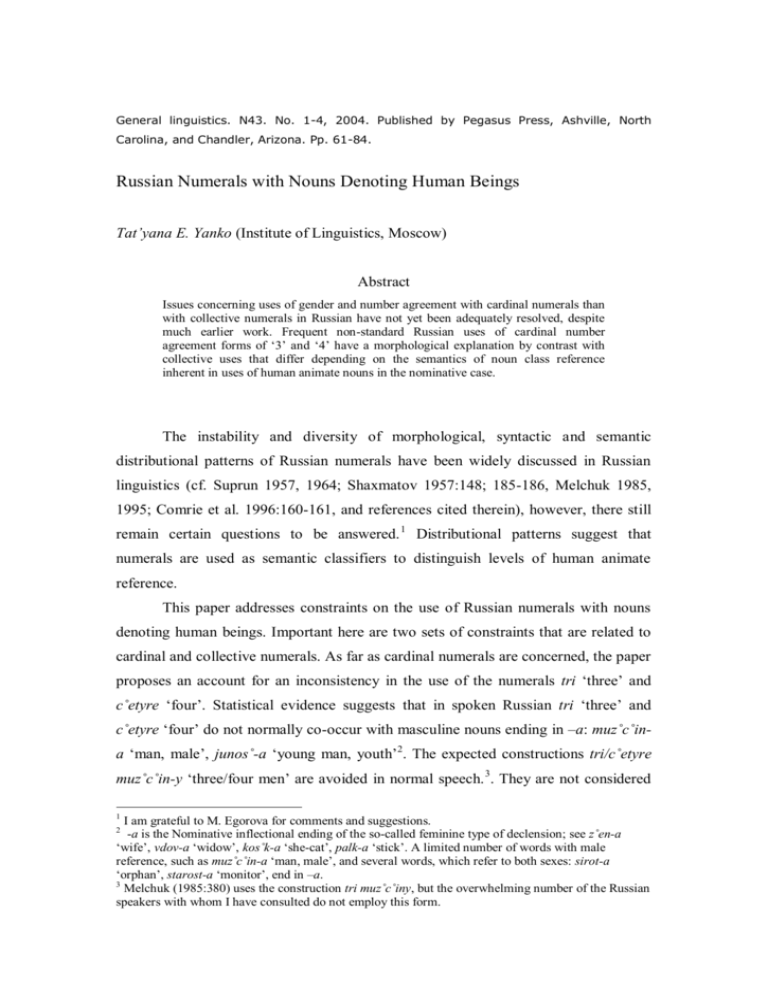
General linguistics. N43. No. 1-4, 2004. Published by Pegasus Press, Ashville, North Carolina, and Chandler, Arizona. Pp. 61-84. Russian Numerals with Nouns Denoting Human Beings Tat’yana E. Yanko (Institute of Linguistics, Moscow) Abstract Issues concerning uses of gender and number agreement with cardinal numerals than with collective numerals in Russian have not yet been adequately resolved, despite much earlier work. Frequent non-standard Russian uses of cardinal number agreement forms of ‘3’ and ‘4’ have a morphological explanation by contrast with collective uses that differ depending on the semantics of noun class reference inherent in uses of human animate nouns in the nominative case. The instability and diversity of morphological, syntactic and semantic distributional patterns of Russian numerals have been widely discussed in Russian linguistics (cf. Suprun 1957, 1964; Shaxmatov 1957:148; 185-186, Melchuk 1985, 1995; Comrie et al. 1996:160-161, and references cited therein), however, there still remain certain questions to be answered. 1 Distributional patterns suggest that numerals are used as semantic classifiers to distinguish levels of human animate reference. This paper addresses constraints on the use of Russian numerals with nouns denoting human beings. Important here are two sets of constraints that are related to cardinal and collective numerals. As far as cardinal numerals are concerned, the paper proposes an account for an inconsistency in the use of the numerals tri ‘three’ and c˚etyre ‘four’. Statistical evidence suggests that in spoken Russian tri ‘three’ and c˚etyre ‘four’ do not normally co-occur with masculine nouns ending in –a: muz˚c˚ina ‘man, male’, junos˚-a ‘young man, youth’2. The expected constructions tri/c˚etyre muz˚c˚in-y ‘three/four men’ are avoided in normal speech. 3. They are not considered 1 I am grateful to M. Egorova for comments and suggestions. -a is the Nominative inflectional ending of the so-called feminine type of declension; see z˚en-a ‘wife’, vdov-a ‘widow’, kos˚k-a ‘she-cat’, palk-a ‘stick’. A limited number of words with male reference, such as muz˚c˚in-a ‘man, male’, and several words, which refer to both sexes: sirot-a ‘orphan’, starost-a ‘monitor’, end in –a. 3 Melchuk (1985:380) uses the construction tri muz˚c˚iny, but the overwhelming number of the Russian speakers with whom I have consulted do not employ this form. 2 2 grammatically incorrect, but in these meanings, the collective numerals troe ‘three humans’ and c˚etvero ‘four humans’ predominate: troe muz˚c˚in ‘three men’, c˚etvero junos˚ej ‘four young men’. With regard to men’s first names ending in –a, such as Kol’a, Agrippa, Nikita, there seems to be no general agreement among Russian native speakers as to whether or not the combination of the numerals tri and c˚etyre with such nouns is acceptable. In my own idiolect, combinations like tri Kol-i or c˚etyre Agripp-y are no more acceptable than tri muz˚c˚in-y ‘three men’, but many of my informants, e.g., school teachers, often speak of several participants with the same first name, as in expressions such as tri Koli ‘three Kol’as’ quite possible. What is indisputable with regard, not only to men’s first names in –a but also with regard to men’s first names in general, is that they never combine with collective numerals like troe ‘three humans’ or c˚etvero ‘four humans’: *troe Agripp ‘three Agrippas’. This fact is widely recognized in linguistic literature (e.g., Suprun 1957:80; 1964:74). Moreover, not only first names but also certain categories of common nouns, e.g., c˚etvero adresatov ‘four addressees’, dvoe otcov ‘two fathers’, do not co-occur with collective numerals. Hence, constraints on the use of collective numerals is another category of constraints to be explained. Thus, in section 1 below I focus on low frequency combinations of the type tri/c˚etyre muz˚c˚in-y ‘three/four men’ and suggest why they are generally avoided in speech, while section 2 deals with deviant expressions of the type *troe Agripp ‘three Agrippas’, c˚etvero adresatov ‘four addressees’, dvoe otcov ‘two fathers’ and the reasons for regarding them as such. 1. Cardinal Numerals The low frequency of expressions like tri muz˚c˚iny registered in spoken Russian raises a number of questions. Since the restrictions outlined above seem to concern only a closed set of cardinal numerals, namely tri ‘three’, c˚etyre ‘four’, the compound numerals using these two as their last component (e.g., tridcat’ tri ‘thirty three’), and – in certain idiolects – the numeral dva ‘two’, a question arises as to why the constraints are exclusively imposed on these particular numerals. 4 As stated, this 4 Many informants tend to avoid the form dva muz˚c˚iny ‘two men’ and employ in all cases where there are no any semantic restrictions on combinations with collective numerals the form with dvoe ‘two persons’: dvoe muz˚c˚in ‘two men’. About the semantic distribution of collective pronouns see section 3 paper limits its concerns to the analysis of constructions with human reference. Moreover, this section addresses only the nominative forms of numerals because the oblique cases of numerals are not subject to the constraints to be explained here. To account for why the constraints are imposed only on tri ‘three’, c˚etyre ‘four’ and – in some instances – dva ‘two’, we consider below step by step the syntactic and morphological patterns of Russian numerical expressions of the type, “cardinal numeral plus noun” in the nominative case. 1. The numeral odin ‘one’ easily combines with nouns of any morphological type of declension. It agrees with the noun in gender, case and number: (1) odin-ø muz˚ik-ø ‘one man’ (2) odn-a z˚ens˚c˚in-a ‘one woman’, (3) odn-i sank-i ‘one sledge’. See glossed examples (1)-(3).5 (1) odin-ø one-NOM.SG.MSC muz˚ik-ø man-NOM.SG ‘one man, one peasant’ (2) odn-a one-NOM.SG.FMN z˚ens˚c˚in –a woman-NOM.SG ‘one woman’ (3) odn-i one-NOM.PL sank-i sledge-NOM. PLtantum ‘one sledge’ 2. The numeral dva ‘two’ in the Nominative agrees with the noun in gender and governs the case form which is homophonous with the Genitive singular 6: (4) dv-a two-NOM.MSC muz˚ik-a man-GEN.SG ‘two men’ (5) dv-e two-NOM.FMN z˚ens˚c˚in-y woman-GEN.SG ‘two women’ 3. The numerical constructions with the numerals tri ‘three’ and c˚etyre ‘four’ follow a pattern similar to that of the numeral dva ‘two’ but with no gender 2 below. Frequency of expressions like dva muz˚c˚iny is not indeed high. In my idiolect, such expressions as dva muz˚c˚iny ‘two men’ are completely acceptable but I cannot ignore the fact that forms like dva muz˚c˚iny are infrequent, while the form dvoe muz˚c˚in is indeed prevalent. 5 The following abbreviations are adopted in this paper: ACC – Accusative, CARD – Cardinal numeral, CMN – Common gender, COL – Collective numeral, DMN – Diminutive, FMN – Feminine gender, GEN – Genitive, MSC – Masculine gender, NOM – Nominative, PL – Plural, PLtantum – Plurale tantum, SG – Singular. 6 The numerical constructions with Pluralia tantum (e.g., troe sanej ‘three sledges’, dvoje s˚tanov ‘two trousers’, troje sutok ‘three astronomical days’, p'at' sutok ‘five astronomical days’) are subject to specific rules that I do not discuss here as others have dealt with them (e.g., Melchuk 1985:385). 4 distinction. In the Nominative they govern the case form homophonous with the Genitive singular: (6) tri three-NOM muz˚ik-a man-GEN.SG ‘three men’ (7) c˚etyre four-NOM z˚ens˚c˚in-y woman-GEN.SG ‘four women’ 4. All the other numerals from five and on govern the Genitive plural with no gender distinctions in the form of the numeral being made: (8) p’at’ five-NOM muz˚c˚in-ø man-GEN.PL ‘five men’ (9) s˚est’ six-NOM ‘five women’ muz˚ik-ov man-GEN.PL ‘six men’ (10) pat’ z˚ens˚c˚in-ø five-NOM woman-GEN.PL s˚est’ six-NOM z˚ens˚c˚in-ø woman-GEN.PL ‘six women’ sem’ z˚ens˚c˚in-ø seven-NOM woman-GEN.PL ‘seven women’ In addition to the facts reviewed above, it must be noted that the constructions with dva ‘two’, tri ‘three’, and c˚etyre ‘four’ are characterized by another specific feature: when a noun in a numerical expression with dva ‘two’, tri ‘three’ and c˚etyre ‘four’ is accompanied by an adjective, the above mentioned numerals govern the Genitive singular of the noun and the Genitive (or Nominative) plural (!) of the adjective. In other words, the noun and the adjective which modifies the noun do not agree in number – the former is singular while the latter is plural: (11) dv-a two-NOM.MSC krasiv-yx muz˚ik-a attractive-GEN.PL man-GEN.SG ‘Two handsome men’ (12) dv-a krasiv-yje muz˚ik-a two-NOM.MSC attractive-NOM.PL man-GEN.SG ‘Two handsome men’ (13) dv-e krasiv-yje z˚ens˚c˚in-y women’ two-NOM.FMN attractive-NOM.PL woman-GEN.SG (14) dv-e women’ two-NOM.FMN krasiv-yx z˚ens˚c˚in-y attractive-GEN.PL woman-GEN.SG ‘Two beautiful ‘Two beautiful 5 For instance, in examples (11)-(12) the word form muz˚ik-a is singular, while the word forms krasiv-yx (see (11)) and krasiv-yje are plural (cf. (12)). As for the case of the adjective, the Nominative and the Genitive case forms vary: the feminine constructions prefer the Nominative, while the masculine constructions tend to occur in the Genitive. The other relevant feature of the constructions with dva ‘two’, tri ‘three’, and c˚etyre ‘four’ to be mentioned here is the homonymy between the Genitive singular and Nominative plural forms found with most feminine nouns 7. Consider (15) and (16) with homophonous forms bolded. (15) Prishli have come (16) Prishli have come z˚ens˚c˚in-y woman-NOM.Pl ‘Women have come’ tri z˚ens˚c˚in-y three woman-GEN.SG ‘Three women have come’ Since, as it has already been mentioned above, in feminine numerical constructions, which include adjectives, the Nominative form (plural) of adjectives is preferred to the Genitive form8, feminine constructions with adjectives also have homophonous Genitive singular and Nominative plural forms (see Suprun 1957:60; 1964:884; Vinogradov 1972:245). Contrast (17) to (18): (17) Prishli come’ have come (18) krasiv-yje z˚ens˚c˚in-y ‘Beautiful women have attractive-NOM.PL woman-NOM.Pl Prishli tri have come three krasiv-yje z˚ens˚c˚in-y attractive-NOM.PL woman-GEN.SG ‘Three beautiful women have come’ 7 There are several feminine nouns that distinguish Genitive singular and Nominative plural by stress alone. Such nouns include vdova ‘widow’, z˚ena ‘wife’, sestra ‘sister’, snoxa ‘daughter-in-law’, kinozvezda ‘film-star’. With these words, the Genitive singular has end-stress, while the Nomintaive singular has stem-stress. Consider the expressions syn vdov-Y ‘widow's son’, including the word vdova ‘widow’ in the Genitive singular, and Prishli vdOvy ‘Widows have come’, including the word vdova in the Nominative plural. Stressed vowels are marked by capital characters. 8 It should be noted that within numerical constructions adjectives in the Genitive are also possible: Prishli tri krasiv-yx z˚ens˚c˚in-y ‘Three beautiful women have come’ have come three attractive-GEN.PL woman-GEN.SG This case form is not homophonous with the Nominative plural: see (17). 6 Such homophony has its basis in the fact that semantically the numerals dva ‘two’, tri ‘three’ and c˚etyre ‘four’ are associated with the concept of plurality. By contrast, no parallel homophony is found in constructions with the nouns of the masculine types of declension: (19) Prishli have come muz˚ik-i man-NOM.Pl (20) Prishli have come tri three muz˚ik-a man-GEN.SG ‘Men have come’ ‘Three men have come’ Moreover, when a masculine noun is accompanied by an adjective, the Genitive form of the adjective is generally preferred to the Nominative form. Therefore, out of the two options (21) and (22), the first one (with Genitive plural adjective) appears to be far more common than the second one (with agreeing Nominative plural adjective) (see statistics in Suprun 1957:73, the analysis in Comrie et al. 1996:160-161, and references cited therein). (21) tri three-NOM krasiv-yx muz˚ik-a ‘Three handsome men’ attractive-GEN.PL man-GEN.SG (22) tri three-NOM krasiv-yje muz˚ik-a ‘Three handsome men’ attractive-NOM.PL man-GEN.SG Therefore, it should be pointed out that the numerical constructions with the numerals dva ‘two’, tri ‘three’, and c˚etyre ‘four’ in the feminine follow different syntactic patterns from those in the masculine. Due to the effect of homophony in the feminine, the syntactic relation between the numeral and the noun is very similar to agreement, while in constructions with nouns that are declined like the masculine muz˚ik the relation is rather one of government than agreement. We thus conclude that Russian numerical constructions with nouns denoting human beings follow four separate morphosyntactic patterns. (i) The adjectival pattern of the numeral odin ‘one’: see examples (1)-(2). (ii) The pattern of the numeral dva ‘two’, where the numeral explicitly manifests the category of gender; from the viewpoint of syntax, this pattern is identical with that for the numerals tri ‘three’ and c˚etyre ‘four’ (see (iii) below). (iii) The pattern of the numerals tri ‘three’ and c˚etyre ‘four’, where the numeral is not marked for gender, but the feminine and the masculine types of numerical constructions have different syntactic preferences (see above). 7 Hence, within type (iii) one distinguishes two subtypes: (iii.i) the masculine type (tri krasiv-yx muz˚ik-a, see example (21)) and (iii.ii) the feminine type (tri krasiv-yje z˚ens˚c˚in-y, see example (18)). (iv) The substantive pattern of the numeral p’at’ ‘five’ and numerals after five (except for compound numerals using simple numerals before five as their last component, e.g., tridcat’ tri ‘thirty three’), in which there are no structural differences whatsoever for feminine vs. masculine gender nouns. The diversity of morphosynatctic patterns for Russian numerical constructions outlined above is further complicated by the fact that certain nouns of male reference are declined like the feminine z˚ens˚c˚ina ‘woman’. Therefore, in theory in constructions with the cardinals dva ‘two’, tri ‘three’ and c˚etyre ‘four’ such nouns should fit in with the feminine pattern (iii.ii). In practice, however, such constructions, as it has already been pointed out, are generally avoided. Consequently, I hypothesize that the feminine syntactic pattern produces a “femininizing” effect on nouns with male reference. This would explain why such constructions as tri/ c˚etyre muz˚c˚in-y ‘three/four men’ and – in certain idiolects – dva muz˚c˚in-y ‘two men’ are accepted as peripheral by the majority of Russian speakers. Quite similarly, the collective numerals, which, being generally applicable to nouns with male reference, serve as the “masculinizing” context for the nouns with the female reference: ?troe z˚ens˚’s˚’in ‘three women’. This fact of Russian is widely recognized and comprehensively discussed by grammarians (Suprun 1957:80, 1964:74; Vinogradov 1972:249, Russkaja grammatika 1982:79). For constructions with the numeral dva ‘two’, the “femininizing” effect is partly neutralized by the explicit contrast “feminine vs. masculine”, which is manifested by the gender of the numeral dva: see dv-a.MSC vs. dv-e.FMN. This can serve as an explanation for the fact that the combination dv-a junos˚i ‘two young men’ (see dv-e devus˚ki ‘two girls’) is considered overall more acceptable than tri junos˚i ‘three young men’ (see tri devus˚ki ‘three girls’).9 There is other linguistic evidence supporting the “femininizing” effect hypothesis outlined above. So-called common gender nouns in –a (sirot-a ‘orphan’, starost-a ‘monitor’), which are used in both the masculine and the feminine (see (23)), with the numerals tri ‘three’ and c˚etyre ‘four’ are accepted as referring to females rather than males. Thus, example (24) vdova i tri sirot-y ‘a widow and three 9 I use the construction dva junos˚i ‘two young men’ without hesitation, but never tri junos˚i ‘three young men’. 8 orphans’ is more likely to be understood as ‘a widow and three daughters’ than as ‘a widow and three sons’ or as ‘a widow and three children of both sexes’. (23) (24) bedn-aja sirot-a; poor-NOM.FMN orphan-NOM bedn-yj sirot-a poor-NOM.MSC orphan-NOM ‘poor she-orphan’ ‘poor he-orphan’ vdova i tri widow and three sirot-y orphan-GEN ‘A widow and three orphans’ Mention is to be made that these preferences are merely more frequent; the masculine interpretation of tri sirot-y ‘three orphans’ in (24) is also possible. For more examples of the type tri ‘three’ or c˚etyre ‘four’ plus a word of common gender in –a, consider (25) and (26) with the word sud’j-a ‘judge’, which also occurs in both genders. Example (25) from B.Okuds˚ava’s song with tri sud’ji ‘three judges’ is considered normative because of the explicit female reference (the three judges are sisters), whereas sentence (26) taken from a TV report covering the American president’s election sounds somewhat odd in the context of the knowledge that the judges in question were all males. (25) Tri three.NOM z˚en-y, wives-GEN.SG tri sestr-y, three.NOM sisters-GEN.SG tri sud’j-i miloserdnyx otkryvajut bessroc˚nyj three.NOM judges-GEN.CMN merciful-GEN.PL open termless kredit-ø credit-ACC dl’a men’a for me ‘Three wives, three sisters, three merciful judges are giving me unlimited credit.’ (26) ? c˚etyre sud’ji iz semi vyskazalis’ za ruc˚noj perec˚et four judges from seven declared for manual re-count golosov votes v in s˚tate Florida state Florida ‘Four out of the seven judges called for a manual re-count of votes in the State of Florida’. Thus, in numerical constructions with the cardinals dva, tri and c˚etyre, the feminine morphosyntactic pattern required for nouns ending in –a appears to be inconsistent with the lexical meaning of the words denoting males, such as muz˚c˚in-a 9 ‘man’, junos˚-a ‘young man’, vojevod-a ‘governor’. To refer to the respective meaning, the Russian language has developed substitute means with the use of the collective numerals dvoe ‘two humans’, troe ‘three humans’ and c˚etvero ‘four humans’. From the viewpoint of semantics the collective numerals are more specific than the cardinal numerals, but they are less complicated from the viewpoint of syntax, cf. examples (27), including masculine words of the declension in -a – muz˚c˚ina ‘man’, junos˚a ‘young man’, vojevoda ‘governor’: (27) dvo-e muz˚c˚in-ø; two-NOM man-GEN.PL ‘two men’ c˚etver-o four-NOM vojevod-ø governor-GEN.PL troe junos˚-ej; three-NOM young man-GEN.PL ‘three young men’ ‘four governors’ The meaning of the collective numerals is discussed in section 2 below. Mention is to be made that beyond specific constructions with the abovementioned numerals, masculine nouns in –a do not have any “feminine” effect. The “feminizing” effect seems to be limited only to the contexts where formal morphological properties of the noun, i.e. its declension, turn out to be relevant for the choice of the feminine vs. masculine phrase pattern. Thus, the fact that the constructions tri/ c˚etyre muz˚c˚in-y ‘three/four men’ do not belong to standard Russian has a “morphological” explanation. The second question of this paper (Section 2) concerning collective numerals distribution, however, requires a semantic explanation. 2. Collective Numerals This section addresses the distribution of the collective numerals. As it has been mentioned above, a specific feature of Russian collective numerals is their restricted combinability with men’s first names and with certain categories of common names denoting human beings, irrespective of their declensional pattern: *troe Nikit-ø, ‘three Nikitas’, c˚etvero John-ov ‘four Johns’, ?dvoe otc-ov ‘two fathers’. As for numerals, the restrictions discussed in this section apply to all collective numerals. The case form of a numeral in a numerical construction is not relevant to the problem addressed here. The fact that in standardized Russian collective numerals do not co-occur with nouns denoting females has been adequately discussed (Suprun 1957:80, 1964:74; Vinogradov 1972:249, Russkaja grammatika 1982:79) and needs no further 10 discussion here. The goal of this section is to argue that the restrictions on the use of collective numerals are of a semantic nature, i.e., certain semantic parameters of the collective numerals turn out to be incompatible with the semantics of first names and with some other semantic categories of nouns referring to human beings. 10 The incompatibility of collective numerals with first names raises a number of questions. Why do the restrictions concern only first names? And why they do not concern family names: *dvoe Johnov ‘two Johns’ vs. dvoe Johnsonov ‘two Johnsons’? See example (26) cited in Suprun 1957: 80, 1964: 74: (29) My s˚estero We six persons Geretti sideli doz˚idajas’ Geretti sat waiting svojej oc˚eredi one’s turn ‘We, six people called Geretti, were sitting waiting for our turn’ (Kuprin) Why, at the same time, are these restrictions imposed on some other categories of nouns with male reference?11 Consider (30)-(32): (30) * Vas’a vsegda Vas’a always odin, sc˚ital, believed kotoryj rodil, c˚to that i u nego dvoe otcov: at him two fathers; drugoj, kotoryj the one which gave birth (to him) and the other who (31) * Dl’a uc˚astija v for participation in dvoe two (32) mel’nikov millers i and dramax dramas Pushkina of Pushkin vyrastil; raised (him) podgotovleno are rehearsed troe jurodivyx; three God’s fools ? Do moego vystuplenija es˚c˚o troe dokladc˚ikov Before my presentation still more three paper-givers In order to answer these questions I outline below the systematic polysemy of the words with human reference. Categories of sub-meanings are presented in section 2.1. This categorization seems to shed light on regularities in the use of the collective numerals discussed in section 2.2. 10 Collective numerals apply not only to men but to the nouns of certain non-human classes as well: troe sanej ‘three sledges’, c˚etvero s˚’s˚’en’at ‘four puppies’. About the distribution and the evolution of the constructions including collective numerals and nouns with non-human reference see Suprun 1957: 81-82; Shaxmatov 1957:148; 185-186; Vinogradov 1972:248-250; Melchuk 1985:381-399. The facts cited by Shaxmatov and other authors show that the non-human constructions can be recognized as an isolated set and is not discussed here. One reason for this is that they have different origin than those denoting male persons. 11 There is a considerable body of literature devoted to restrictions and distributional preferences of collective pronouns (see Suprun 1957; 1964; Melchuk 1985;1995). 11 2.1. Subcategories of nouns with human reference The following semantic subcategories can be distinguished. (I) ‘A human being as an individual specified by a certain ontological parameter’ (section 2.1.1); (II) ‘The name or function of a human being’ (section 2.1.2); (III) ‘A human being as a body’ (section 2.1.3); (IV) ‘A human being as a measure’ (section 2.1.4). 2.1.1. Human being as an individual The crucial point about the use of a noun to refer to an individual is that the noun refers to an active person endowed with mind, heart and flesh. It is characterized by a distinctive parameter. This parameter constitutes a category of elements that embody this parameter. Thus, the noun soldier in this sense refers to a person whose distinguishing ontological characteristic is that of “being a soldier”: (33) Na doroge pojavils’a soldat s ruz˚jem. On road appeared soldier with gun ‘A soldier with a gun appeared in the road’. Section 2.1.1 (definition (I)) describes the prototypical meaning of a noun with human reference. However, nouns with human reference are not always used in this particular sense: in some uses certain relevant parameters of definition (I) can be missing. Such uses are described in sections 2.1.2-2.1.4 below. 2.1.2. Names and functions of people Subcategory II of ‘names and functions of a human being’ includes proper (personal) names, nouns referring to titles, ranks, and academic degrees, as well as the functions and roles performed by people in specific situations, e.g., parts in a play. In examples (34)(a-d) below, nouns referring to titles, positions, and functions are marked with spacing: (34) (a) Objavlajets’a is announced vakansija vacancy menedz˚era of manager ‘A vacancy for a manager is announced’; (b) On moj nauc˚nyj rukovoditel’ 12 He my scientific supervisor ‘He is my supervisor’; (c) On poluchil He got zvanie rank admirala of admiral ‘He has got the rank of admiral’; (d) Avtor Author knigi – NN of book NN ‘The author of the book is NN’ Examples (34)(a)-(d) show that, in contrast to subcategory (I), a person named N may not personify the parameter N. Subsections 2.1.2.1-2.1.2.3 below detail differences. 2.1.2.1 Roles in plays and nicknames. A person may only have the name N but not really be N. For instance, the person performing the part of the miller (e.g. in a play) is only called a miller, but he is not a real miller. Similarly, a person nicknamed Wooden Leg does not belong to the category of wooden legs. In other words, this section describes the use of the words with human reference when a human being does not really possess the distinctive feature that would be assigned to him/her by the name. Thus, the “missing” component of the meaning is that of assigning a characteristic to a person. 2.1.2.2. First names. The name of N may convey no characteristics at all because it serves only as a name without signifying anything (see Mill 1891:20). This is true of people’s first names. Thus, the name John does not assign any distinctive feature to the person called John. Here, the “missing” component of meaning is that of the ontological characteristic to specify a person. 2.1.2.3. Social roles, positions and ranks. A name may occur as a name of a parameter in abstraction from a person to be specified by this parameter. For instance, the noun manager in the meaning of ‘the post of manager’ refers to a specific position rather than to a person filling that position. Thus, the “missing” component of meaning is that of a real person him/herself endowed with mind, heart and flesh. With regard to the last category of roles, positions, and degrees it should be pointed out that the polysemy between ‘a role itself’ and ‘a person playing that role’ is 13 characteristic of most names with human reference. For instance, professor ‘professor’ can denote both an academic position or title (He has got the title of professor) and a man/woman who embodies the parameter “to be a professor” in him/herself, i.e., a professor as a real person (A professor entered the classroom). For certain words with human reference, however, only one of the two meanings is common. For instance, soldat ‘soldier’ tends to occur in the meaning of a person specified as a soldier: a soldier is predominantly a man who serves as a junior military man. Brigadir ‘brigadier’ and vice-admiral ‘vice-admiral’, by contrast, are words that tend to denote the respective ranks.12 Names of lower ranks by comparison with names of higher ranks (soldiers vs. generals, seamen vs. admirals and students vs. deans) are more likely to have real persons as their referents. Lower positions are generally shared by a large number of ordinary people. They can be found in great quantities in manoeuvres, on ships and in university buildings. Words denoting higher ranks (e.g., general, admiral, or dean), by contrast, usually refer to the respective posts rather than to real people. Low ranks are “human” and assemble people together, while high ranks instead reflect the social hierarchy that separates people. The last formulation, however, expresses only a general tendency because low ranks can also be conceptualized in language as ranks, while designations for high social status can be comprehended as persons. For instance, Russian kapral ‘corporal’ and serz˚ant ‘sergeant’ are understood as ranks, though the lowest ones, while boyarin ‘boyar’, senator ‘senator’, and parlamentarij ‘parliamentarian’ are persons. Certain – very rare – nouns with human reference do not occur as names of individuals but rather as names of functions or roles: adresat ‘addressee’, zajavitel’ ‘declarant’, istec ‘plaintiff’, juridic˚eskoe lico ‘juridical person’.13 (35)?Krasnos˚’s˚˚’ekij adresat/predjavitel’/otvetc˚ik komnatu 12 voshel v Apresjan (1974:202) discusses semantic derivation, which is characteristic of the words denoting ranks, from the meaning ‘rank, title, position’ to the meaning ‘person holding the rank or occupying the position’; see Russian words whose meanings are formed by the concept of a rank or title: akademik ‘academician’, baron ‘baron’, imperator ‘emperor’, kancler ‘chancellor’, maharadzha ‘maharajah’, polkovnik ‘colonel’, president ‘president’, premier ‘prime minister’. 13 Contexts can be distinguished which modify the meaning of words referring to roles and functions like addressee and plaintiff giving them the capacity to denote individuals. One such context uses the deictic pronoun 'this': These four juridical persons can form an independent organization, see Melchuk 1995: 399. (For the sake of simplicity, I give here an English example because the difference between English and Russian is negligible here.) 14 red-cheeked adressee/cheque-bearer/defendant entered in room14 ‘A red-cheeked addressee / cheque-bearer / defendant entered the room’. To sum up, nouns with human reference can denote not only a human being who is playing a certain role, but also the role itself. So, three semantic categories of nouns can be distinguished. The first category of words, such as professor ‘professor’, can easily manifest both sub-meanings. The second category mainly denotes real people (student ‘student’, soldat ‘soldier’), while the third group of words denotes only roles (adresat ‘addressee’, predjavitel’/podatel’ ‘bearer, bill-bearer, chequebearer’). Further evidence that the opposition between ‘a person’ and ‘a role’ is really relevant for the nouns with human reference comes from the fact that words which tend to refer to active persons as opposed to words which denote functions, titles, and roles rather than individuals have certain idiosyncrasies in their distribution. Example (35) above exemplifies contexts distinguishing between the words of the category denoting persons and the category denoting role. The words of roles and functions avoid contexts like A red-cheeked X entered the room. A morphological category of diminutives provides further evidence: the words denoting functions, ranks and titles, as a rule, do not form diminutives. (a) student-ik ; student-DMN matros-ik; paren’-ek; soldat-ik; seaman-DMN fellow-DMN soldier-DMN (b) ?admiral’-c˚ik; ?akademic˚-ek; ?shef-ik; admiral-DMN academician-DMN chief of a department-DMN (c) *adresat-ik; adressee-DMN * avtor-c˚ik (*avtor-ik) author-DMN Example (a) demonstrates that the words denoting people easily incorporate diminutive suffixes, example (b) show that the words denoting ranks and titles can 14 The analysis exemplified here by the Russian words is fully applicable to their English equivalents. 15 hardly acquire a diminutive meaning, while the words in examples (c) are completely inconsistent with diminutive suffixes. 2.1.3. Human being as a body Occurrences of nouns with human reference in the meaning of a physical body are very rare: (36) C�elovek human being na 90 procentov sostoit iz vody. on 90 per cent consists from water ‘A human body consists of 90% water.’ On he spotknuls’a stumbled ob over Gogol’a Gogol’ i and upal. fell ‘He stumbled over Gogol and fell down.’ (On personal nouns in the non-standard meaning of a physical body, see Zalizniak 1973.) 2.1.4. Human being as a measure The concept of a human being understood as a unit of measure is very close to the concept of a human being understood as a body because in both cases the core concept denotes a physical object; cf. section 2.1.3 (on words with human reference used to refer to a measure; see Melchuk 1995:402) and examples (37)-(39) below. In (37), the noun zritel’ ‘spectator’ is used in the meaning of ‘a human being as a measure of space’: (37) On sidel v kresle za dva zritel’a ot men’a he sat in arm-chair in two spectators from me ‘He sat two seats away from me’; On stojal v r’adu za c˚etyre nac˚ala he stood in row in four soldata soldier from ot beginning ‘His place in the rank was four soldiers from the head’. In (38), a human being serves as a measure of time: (38) Do moego Before my doklada presentation jes˚’s˚’o more one ‘There is one paper-giver before my presentation’. odin dokladc˚ik paper-giver 16 In (39), a noun referred to a human being is used in the meaning of a measure of weight: (39) Odin one štangist weight-lifter vesom in weight kak as dva two z˚okeja jockey ‘One weight-lifter weighs the same as two jockeys’. To contrast (III) (subsection 2.1.3) and (IV) (subsection 2.1.4) to the prototypical use of a noun with human reference (cf. definition (I), subsection 2.1.1), it should be mentioned that only a human body – its weight, length, volume, but not a person him/herself – is relevant for (III) and (IV). Thus, the “missing” component of meaning is that of soul, heart , mind and ot her inherent charact er ist ics o f a person except for physical body alone. To sum up subsection 2.1: the key concept of a human being as it is presented in the Russian language is that of a person who is characterized by a certain ontological parameter. Other – peripheral – human aspects can also be represented by the words denoting people: these are a human name, a role, a title, or a function of a person, and a human body. 2.2. Collective numerals with the nouns that have human reference Russian collective numerals denote human beings 15 – predominantly males – joined in groups by a common interest, a job, or a nationality, or by some other parameter. These are soldiers, students, seamen, parliamentarians, Muscovites, Martians who have assembled together. Therefore, the collective numerals apply to people and rather to males than to females, and a collective numeral denotes a group of men specified by a certain parameter. The definition of a collective numeral is consistent with the definition of subcategory (I) (see section 2.1). This completely accounts for the restriction of the type like dvoe Kol’ ‘three Kol’as’ or semero Basilej ‘seven Basils’. Kol’a and Basil are first names with reference to an individual human being, while generic first names do not have any referential meaning. Consequently, they cannot denote a person qualified by any parameter (as the definition of a collective numeral demands): first names do not refer to any conceptual parameter. Therefore, first names do not combine with collective numerals. 15 About collective numerals with non-human reference, see footnote 10 above and Suprun 1957:81-82; Shaxmatov 1957:148; 185-186; Vinogradov 1972:248-250; Melchuk 1985:381-399. 17 Similarly, examples (40)-(50) below demonstrate the inability of Russian collective numerals to combine with nouns understood in the meanings specified in (II)-(IV) (see section 2.1), i.e., the meanings distinct from the one characterized by definition (I). Definition (II) of a human being as a role or function helps to explain why example (30) is ungrammatical. (For convenience, I repeat example (30) as example (40)): (40) Vas’a Vas’a vsegda always otcov: odin, sc˚ital, believed that kotoryj rodil, i c˚to at u him nego two *dvoe drugoj, kotoryj vyrastil fathers the one which begot (him) and the other who raised (him) The universe is ordered in such a way that a person can have only one father: if people say that Vas’a has two fathers it means that one of his fathers is not a biological father but is merely called a father. It was, however, demonstrated above that nouns used as names do not co-occur with collective numerals, and neither do the names of unique objects. See the standard expression (41) where the collective numerals troe ‘three persons’ and četvero ‘four persons’ easily co-occur with the word brat ‘brother’ because a person can really have more than one brother. (41) U Vasi At Vas’a troe / c˚etvero three.COL / four.COL brat’ev brothers ‘Vas’a has three / four brothers’. Hence, in contexts like (40), only the cardinal numeral dva ‘two’ can be employed because cardinal numerals are not sensitive to the distinction ‘person’ vs. ‘name’: (42) Vas’a vsegda sc˚ital, otca Vas’a always believed that c˚to u at him nego dva two.CARD fathers ‘Vas’a believes that he has two fathers’ A specific context may give to the noun otec ‘father’ the ability to co-occur with a collective numeral, see (43): (43) V otvet na pros’bu uchitel’nicy otkliknulis’ tol’ko troe otcov in response to request of the teacher responded only three.COL fathers ‘When the teacher asked for help only three fathers came to assist in the classroom’ 18 The expression troe.COL otcov ‘three fathers’ in sentence (43) appears acceptable because (43) refers to the fathers of several unrelated school-children. The word otec ‘father’ passes here from the taxonomic category of unique objects to the category whose elements can make up a set. Still, the combination tri.CARD otca ‘three fathers’ would be much more natural in (43) because statistically the word otec ‘father’ is more frequent in combinations with the cardinal numerals. The co-occurrence of nouns with the collective numerals is determined by the structure of a standard situation in which the nouns generally combine with nouns. The word otec ‘father’, due to the order of the world and to the structure of the respective concept does not combine with collective numerals in the majority of contexts. Hence, in those situations where other nouns (e.g. prepodavatel’ ‘teacher’) equally allow both the combination tri.CARD prepodavatel’a ‘three teachers’ and the combination troe.COL prepodavatelej ‘three teachers’, the word otec ‘father’ will prefer the first of the two options: (44) V otvet na pros’bu uchitel’nicy otkliknulis’ tol’ko tri in response to request otca of the teacher responded only three.CARD father ‘When the teacher asked for help only three fathers came to assist in the classroom’. Thus, with the word otec ‘father’, cardinal numerals are undoubtedly more prevalent. Summarizing in other words, the co-occurrence of nouns with numerals and, consequently, the statistical frequency of such constructions is determined by the core of the respective concept. A soldier is conceptualized as a person, therefore the expression troe.COL soldat ‘three soldiers’ is very frequent, and a more universal expression tri.COL soldata ‘three soldiers’ does not supplant troe.COL soldat ‘three soldiers’: the two types of expressions co-exist, each is employed in a more suitable context. Whereas efrejtor ‘lance-corporal’ is a military rank, therefore the expression tri.CARD efrejtora ‘three lance-corporals’ is preferable even in those contexts where from the semantic point of view the expression troe.COL efrejtorov might seem more consistent. To conclude, the co-occurrence of nouns with collective numerals becomes idiomatic. Nouns, which in accordance with their own conceptual standard, denote titles and ranks combine with cardinal rather than with collective numerals even when denoting individuals: (45) K nam To us priblizilis’ approached tri three.CARD admirala admirals 19 ‘Three admirals came up to us’16. With regard to the polysemy of the words referring to ranks and titles, I hypothesize that their highly limited co-occurrence with collective numerals, which has traditionally been being attributed to the semantics of high social status (see Melchuk 1995: 402 and references cited therein), is, in fact, related to the opposition ‘person’ vs. ‘role’ rather than to the opposition ‘upper classes’ vs. ‘lower classes’. Nouns denoting higher ranks and titles (general ‘general’, admiral ‘admiral’) are indeed more often used with reference to ranks, while those denoting lower grades (‘soldier’, ‘seaman’, ‘student’) are usually conceptualized as designations of active people who can get together and move in companies. At a first glance, this might suggest that co-occurrence of such nouns with collective numerals is determined by the scale of ranks. However, as demonstrated in section 2.1 above, designations of lower ranks can also be conceptualized in language as ranks (e.g., efrejtor ‘lancecorporal’), whereas designations of higher ranks can be conceptualized as individuals (boyarin ‘boyar’, archont ‘archon’, senator ‘senator’, parlamentarij ‘parliamentarian’). When the latter is the case, nouns denoting people who belong to a high class can easily combine with collective numerals: dvoe.COL senatorov ‘two senators’, c˚etvero.COL parlamentariev ‘four parliamentarians’, semero.COL bojar ‘seven boyars’, troe.COL archontov ‘three archons’. Mention is to be made here that collective numerals combine with Russian words with the suffix -in (bojar-in ‘boyar’, arm’an-in ‘an Armenian’) irrespective of the differences in the social status. For instance, bojar-in ‘boyar’ undoubtedly belongs to the highest strata, whereas arm’an-in ‘an Armenian’ is not marked for social position. This is due to the fact that the suffix -in renders the idea of a person specified by a certain parameter, cf. sub-meaning (I) in section 2.1: odin bojar-in ‘one boyar’ vs. troe.COL bojar ‘three boyars’, odin marsian-in ‘one Martian’ vs. c˚etvero.COL marsian ‘four Martians’. A question would then arise as to why the restriction such as *dvoe.COL Johnov ‘two Johns’ does not apply to family names (see the correct form dvoe.COL Johnsonov ‘two Johnsons’). What is the crucial difference between first names and family names? Family names differ from first names in that a family name is not only 16 The expression troe.COL admiralov ‘three admirals’ is not totally unacceptible: if admirals gather together so that they make up a group they can be called troe.COL admiralov ‘three admirals’. 20 a name but also a designation of a relevant parameter which consists in referring a person to a certain family or clan. A family name presupposes a set: Johnson or Ivanov is one of several Johnsons or Ivanovs. This accounts for the fact that combinations dvoe.COL Ivanovyx ‘two Ivanovs’, troe.COL Johnsonov ‘three Johnsons’, and s˚estero.COL Geretti ‘six Geretti’ are perceived as normative. 17 Patronymics in this respect are similar to family names. They introduce the parameter ‘having a father of a certain name’. Thus, troe.COL Jaroslavic˚ej ‘three Jaroslavic˚s’ (lit. ‘three Jaroslav’s sons’) can designate either three brothers – Jaroslav’s sons – or three unrelated people whose fathers have the name of Jaroslav. Common names and many other linguistic signs, except for first names and names of unique objects, specify a parameter common to the elements of a certain category. Any parameter presupposes that elements of the respective category are plural. Such plurality is determined by the structure of the linguistic sign itself and could, therefore, be called primary plurality. By contrast, a first name is a token of a unique object. A first name refers to a specific person, not to a set of persons. The situation when various people have the same first names is an occasional phenomenon of life that leads to another type of plurality that could be called induced plurality. Induced plurality is not a linguistic phenomenon but rather an ontological one. Induced plurality does not presuppose any parameter common to all objects of the same name. Collective numerals combine only with those nouns that are understood as plural in the sense of the primary plurality. Collective numerals do not combine with designations of people in the meaning of a physical body (cf. definition (III)): (46) ?Pri vzryve In an explosion obrus˚ilis’ fell in pr’amo straight p’atero five.COL soldat soldiers na men’a upon me i and i and dvoe two.COL pridavili pressed matrosov seamen men’a me Sentence (47) below with the cardinal numerals pa’t’.CARD ‘five’ and dva.CARD ‘two’ sounds much more natural than (46) with the collective numerals p’atero.COL ‘five persons’ and dvoe.COL ‘two persons’ because the expression 17 The combination dvoe.COL Ivanovyx ‘two Ivanovs’ may denote not only relatives but also nonrelative persons who have the same surnames, because Ivanov is a name of a parameter, which presupposes that a person Ivanov by name is not unique and there is a set of Ivanovs. 21 p’atero.COL soldat ‘five soldiers’ refers to living human beings rather than to unconscious bodies. p’at’ five.CARD (47) Pri vzryve In an explosion pr’amo straight obrus˚ilis’ fell in soldat soldiers na men’a upon me i and i and dva two.CARD pridavili pressed matrosa seamen men’a me ‘After an explosion five soldiers and two seamen fell down straight upon me and pressed me with their weight’. Constructions with collective numerals and nouns denoting people in the meaning of a measure are not standard either (cf. definition (IV)). Consider example (32) repeated here with number (48): ? Do moego vystuplenija es˚’s˚’o troe.COL dokladc˚ikov Before my presentation still more three paper-givers (48) In contexts like (48), a construction with the cardinal numeral tri ‘three’ will sound much more natural, cf. (49) below: (49) Do moego vystuplenija es˚’s˚’o Before my presentation still more tri dokladc˚ika three paper-givers ‘There are three more paper-givers before my presentation.’ Consider also the non-standard sentence (50) with the collective numeral troe and its standard variation with the cardinal numeral tri (51): (50) ?On sidel v pervom he was sitting in first (51) On sidel he was sitting r’adu za troe zritelej ot men’a row in three.COL spectators from me v pervom r’adu za tri zritel’a ot men’a in first row in three.CARD spectators from me ‘He was sitting in the first row three spectators away from me.’ To sum up section 2.2, it answers to the question as to why collective numerals do not combine with first names. In addition, it shows why some other categories of nouns referring to humans do not combine with collective numerals. A collective numeral plus a noun with human reference denote a group of people who belong to one and the same ontological category of elements, e.g., soldiers, students, archons, boyars, Martians who have been assembled in one and the same place. By contrast, people with the same Christian names (troe Kol’ ‘three.COL Kol’as’), sets of vacancies to be filled (*p’at’ vakansij: troe professorov and dvoe assistentov ‘five 22 vacancies: three.COL professors and two.COL assistant professors’), or a mass of human bodies (?troe poter’avshix soznanie soldat ‘three.COL unconscious soldiers’) cannot be designated by collective numerals: the respective meaning is expressed by cardinal numerals, which are not sensitive to the semantic oppositions in question. Thus, collective numerals emerge as semantic classifiers of Russian nouns with human reference because co-occurrence of nouns with collective numerals reveals two main concepts of a human being expressed by linguistic means. The first type of concept constitutes the core of a human being as conceptualized in the Russian language. It relates to conscious people who have a particular ontological parameter and to men rather than to women (Prishli troe.COL soldat ‘Three soldiers have come’. Concepts of the second type form the periphery of the semantic field of a human being because these concepts reflect a human being not as a person, but as this or that aspect of a human being: a role or a parameter of a person in abstraction from a person (dolz˚nost’ professora ‘a position of a professor’), a name of a person in abstraction from parameters of a person (Kol’a, John), a human body in abstraction from an individual (spotknuls’a ob Gogol’a ‘stumbled over Gogol’). 3. Conclusion This study examined certain restrictions on the co-occurrence of nouns denoting humans with numerals. The fact that constructions za tri soldata ot nac˚ala ‘within a distance of three soldiers from the head of the row’ and c˚erez c˚etyre zritel'a ot men'a ‘within a distance of four spectators from me’ (see (50) above) do not combine with the collective nouns is widely recognized in linguistic literature (e.g., Melchuk 1985:383). I have suggested here a new explanation for this type of constraint. The inability of nouns in –a, which denote males, to combine with Russian cardinal numerals tri ‘three’ and c˚etyre ‘four’ is explained by the fact that in such contexts nouns with male reference are subject to the feminine morphosynactic pattern of the numerical construction, whereas nouns with male reference belonging to other types of declension in the context of the numerals tri or c˚etyre have syntactic patterns that differ from that of tri and c˚etyre. It limits the co-occurrence of male nouns in –a with the numerals tri and c˚etyre. Thus, the numerals tri and c˚etyre can be recognized as a morphological classifier of nouns with male reference: these 23 numerals mark out a category of masculine nouns in –a, with which they generally do not co-occur. The restriction on the co-occurrence of the collective nouns with first names is accounted for by the fact that collective numerals form a concept of a group of people joined together by a certain ontological parameter. It explains why collective numerals do not combine with words in the meaning of a name, in the meaning of a function, or in the meaning of a physical body. In such contexts cardinal numerals are more frequent because they are indifferent to the semantic distinctions ‘person’’name’-’body’. Hence, collective numerals may be considered as a semantic classifier of words with human reference. The co-occurrence of collective numerals with nouns marks out a category of words that denote people belonging to a certain ontological class and distinguishes this category from other – peripheral – categories that include people’s first names, designations of their roles, functions, positions, titles, ranks, and bodies. References Apresjan, Jurii Derenikovich. 1974. Leksicheskaia semantika: sinonimicheskie sredstva iazyka. Moskva: Nauka. Comrie, Bernard, Gerald Stone, & Maria Polinsky. 1996. The Russian Language in the Twentieth Century. Oxford: Oxford University Press. Melchuk, Igor Aleksandrovich. 1985. Poverxnostnyj sintaksis russkix chislovyx vyrazhenij. Sonderband 16. Wien: Wiener Slawistischer Almanach. ______. 1995. Russkij jazyk v modeli “Smysl=Tekst”. Sonderband 39. Moskva-Wien: Wiener Slawistischer Almanach; Shkola “Jazyki russkoj kul’tury”. Russkaja grammatika 1982 . Volume 2. Moskva: Nauka. Mill, John Stuart. 1891. A System of Logic. London: Longman. Suprun, Adam Evgen’jevich 1957. O russkix chislitel’nyx. Frunze. ______. 1964. Im’a chislitel’noje i jego izuchenie v shkole. Moskva: Uchpedgiz. Shaxmatov, Aleksej Aleksandrovich. 1957. Istoricheskaja morfologija russkogo jazyka. Moskva. Vinogradov, Viktor Vladimirovich 1972. Russkij jazyk (grammaticheskoe uchenije o slove). Second edition. Moskva: Nauka. Zalizniak, Andrej Anatol’jevich 1973. “O ponimanii termina “padezh” v lingvisticheskix opisanijax, 1”. Problemy grammaticheskogo modelirovanija. Moskva. The Russian Academy of Sciences Institute of Linguistics B. Kislovsky 1/12 103009 Moscow RUSSIA [tanya_yanko@list.ru]
